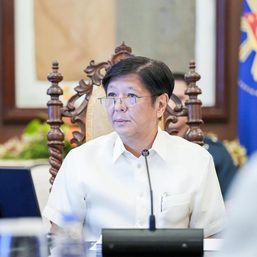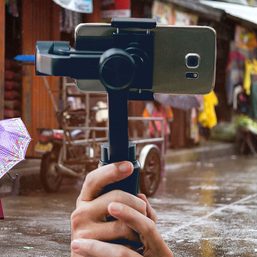SUMMARY
This is AI generated summarization, which may have errors. For context, always refer to the full article.

In late June, President Ferdinand “Bongbong” Marcos Jr. spoke to Filipino journalists about Vice President Sara Duterte’s exit from his Cabinet, what this means for the Uniteam, and his thoughts on the Duterte family’s plans to run for Senate positions in 2025.
Media interviews with the President, like this one, don’t happen very often.
“It’s a cause for concern, because you want to be able to hear regularly from the President outside of his speeches,” said an online news outlet reporter, who spoke to Rappler on condition of anonymity.
A newspaper reporter, who also requested anonymity, told Rappler that the media was “pleasantly surprised” the President entertained all their questions.
“Covering the Marcos administration, I would call it a mixed bag…. President Marcos, from time to time, grants ambush interviews, but there are times when he doesn’t entertain them,” the newspaper reporter said.
Marcos has consistently been difficult to reach and access for journalists who cover him has been challenging. In the lead-up to his 2022 presidential victory, Marcos and his campaign made calculated efforts to shun the media. On his first day as president-elect, he invited only three reporters to a “press conference.” The first few months of his presidency saw pro-Marcos vloggers attempting to lobby for access to official Malacañang events, but they later disbanded.
When Marcos became president, media access remained managed.
“If you recall, during Marcos’ candidacy, their strategy was, ‘less talk, fewer mistakes,’ right? The President was criticized for avoiding debates and not granting interviews to some media entities. I think they are applying the same strategy now,” the newspaper reporter added.
Rappler spoke to two Palace reporters about their firsthand experiences covering the President, as well as two experts familiar with the media landscape in the Philippines. How difficult is it for reporters to get in touch with President Marcos, and what does this mean in the bigger scheme of things?
No presidential spokesperson, different press briefings, and limited access
For the two Palace reporters who spoke to Rappler, among the biggest hurdles in covering the Marcos administration is the lack of a presidential spokesperson.
Marcos abolished the position of presidential spokesperson in his second executive order. Instead, Marcos appointed a press secretary, and later the head of his Presidential Communications Office (PCO), whose functions are different from that of a spokesperson who can directly speak for the President.
“In past administrations, if the president doesn’t speak [on a certain matter], there’s a designated spokesperson who can speak on behalf of Malacañang. These days, we don’t have that,” the online reporter explained.
The newspaper reporter also said relaying of information is more “centralized” in the Palace, which can also be an issue for Palace reporters trying to source firsthand information.
“For example, in the House of Representatives, there are more than 300 lawmakers to choose from to interview, right? Or the Senate, you’ll have over 20 senators to talk to…. In the Palace, you don’t interview the President often, so ideally, they’ll have a talking head. And if the talking head doesn’t speak, that’s when we’ll have a problem,” the newspaper reporter explained.
So what do press briefings look like without a presidential spokesperson? Now, Palace press briefings under the Marcos administration typically cover updates from different government agencies, which can make it difficult for reporters who are expected to write about issues related to Malacañang.
“Because these agency secretaries come to Malacañang, we Malacañang reporters – who aren’t familiar with those beats and agencies – are sometimes caught off-guard,” the online reporter said.

Malacañang also currently has a “pool” system, which means only a handful of news organizations get access to certain events, the newspaper reporter explained. Prior to the Marcos administration, official Palace events were open to all media outlets, but now some events only have two, three, or five slots allocated to reporters. Sometimes slots are limited due to security reasons, such as when Ukrainian President Volodymyr Zelenskyy visited the Philippines.
Here’s how it works: The PCO informs the Malacañang Press Corps (MPC) about the number of available slots for a certain event, and MPC members get to signify whether they want to cover the said event. If the list of MPC members interested in covering goes beyond the number of allocated slots, the MPC draws lots using a randomized app. (Editor’s note: A previous version of this article said the PCO drew lots instead of the MPC. This has been corrected.)
“In fairness to the Palace, they don’t dictate who covers the event. Fate will decide via the random app,” the newspaper reporter said.
One-on-ones are also rare for Marcos. Arguably Marcos’ most memorable one-on-one with the media is his March interview with ABC journalist Sarah Ferguson, who called him out for laughing after she asked him about his family’s ill-gotten wealth. Ferguson later revealed in a TikTok video that Marcos’ staff had even tried to stop the interview.
Danilo Arao, associate professor of journalism at the UP College of Mass Communication, said Ferguson was praised for confronting Marcos with tough questions as journalists in the Philippines aren’t typically given the same privilege.
“The bigger question is why Filipino journalists – at least the more critical ones – are not given the same opportunity to have a one-on-one with Marcos Jr.,” he said.
But the newspaper reporter explained that foreign media have more leeway to be critical of Marcos, as their interviews with the Philippine President are typically one-shot deals. Meanwhile, Malacañang reporters who have to maintain a good working relationship with the Palace have to be more practical and strategic about asking critical questions, so they avoid getting cut off for the rest of the President’s term.
“If foreign journalists piss off Malacañang, and should Malacañang decide, ‘No, we’re not going to grant interviews to Ferguson anymore’…. They have nothing to lose. ABC can go on with its life covering other issues…. Malacañang reporters, especially, will not do that because of fear of loss of access,” the newspaper reporter said.

How does Marcos compare to Duterte?
Compared to his immediate predecessor Rodrigo Duterte, Marcos appears to be friendlier towards the press. But does this mean Marcos is a champion of press freedom? Far from it, experts say.
Arao said the Marcos administration still lacks a clear policy in terms of promoting and upholding press freedom. “Their claims of being press freedom champions from time to time, as in the case of World Press Freedom Day, are obviously not enough,” he said.
Jonathan de Santos, chairperson of the National Union of Journalists of the Philippines (NUJP), acknowledged that Marcos has “been saying a lot of the right things” regarding press freedom. However, he’d like to see concrete follow-throughs, such as certifying the decriminalization of libel as urgent.
“[It] would really be helpful to show that, ‘Yeah, we have a free press. We protect our journalists. Freedom of expression is alive….’ They’re already making that claim, but we know that isn’t true,” De Santos said.
During Marcos’ first year as president, the Philippines received its highest World Press Freedom Index ranking in six years. Marcos may not curse and threaten the media the way Duterte did, but that doesn’t mean covering his administration is easy.
For instance, the Marcos administration holds fewer press briefings. Under the Duterte administration, what was then the Presidential Communications Operations Office held daily briefings during the COVID-19 pandemic. Duterte’s spokespeople, such as Harry Roque and Salvador Panelo, also frequently faced the media. Now, the Palace typically only holds press briefings once a week.
The newspaper reporter – who covered both Duterte and Marcos – said the current administration is slower to respond to, and issue statements about, sensitive breaking events, such as the June Ayungin Shoal incident and Sara Duterte’s resignation. Sometimes issues pass by without the Marcos administration ever issuing an official statement.
The PCO also asks reporters to send in questions in advance, and insiders said the PCO will even refuse to entertain certain questions, especially if they’re about events that just happened. Ambush interviews are also closely managed by the PCO, where moderators call reporters one by one to ask questions.
Despite his reputation as a press freedom predator, former president Duterte was open to talk about many issues with the press, the newspaper reporter told Rappler. Duterte usually accommodated questions from the media about any topic, except one – his health.

Attacks against journalists persist
Beyond accessibility and transparency, attacks and harassment against journalists have persisted under the Marcos administration.
Alternative news sites Bulatlat and Pinoy Weekly remain blocked two years after the National Telecommunications Commission order. “If we’re talking about a government that says, ‘We prefer a critical press,’ these two websites are very critical, which is why they were targeted…. It would be a good move or a good indicator of how free we are, or how tolerant [the] government is of the press,” De Santos said.
An NUJP study released earlier this year found that more than half of red-tagging cases against journalists in the past eight years were state-sponsored. Out of a total of 159 incidents recorded between 2016 and 2024, 90 cases involved journalists from alternative media, while 69 cases involved journalists from dominant or mainstream media.
De Santos also said media harassment may not be common in Manila, but that harassment against community journalists is “the same, if not worse” under Marcos. For instance, the Marcos administration has not taken any steps to free Tacloban-based journalist Frenchie Mae Cumpio, who marked her fourth year in jail after she was arrested over trumped-up charges.
As of writing, a total of four journalists have been killed under Marcos’ term as president – Rey Blanco, Percy Lapid, Cresenciano Bunduquin, and Juan Jumalon. Blanco, Bunduquin, and Jumalon were based in different provinces across the country. Lapid was the only one killed in Metro Manila, and NUJP said this had “[indicated] how brazen the perpetrators were.”
“There is a tendency for the government and those in power to label journalists as, at the very least, troublemakers…. That’s our common struggle as journalists. Whether you’re from mainstream media or alternative media outlet, or whatever your politics are, it’s the same. We shouldn’t be labeled as enemies or treated as such,” De Santos said.
Arao said media repression has been “normalized” in today’s media landscape, no thanks to laws weaponized against journalists. “In the same way that a journalist’s obligation is to make the uninteresting interesting, a journalist cannot afford to make the unacceptable acceptable,” he said.
The Philippines still has a long way to go in protecting journalists and allowing them to do their job to the fullest of their ability. The World Press Freedom Index saw the Philippines fall two places in 2024, and Reporters Without Borders said the country remains “one of the world’s most dangerous” for journalists.
“Even after ’86, even if we say that was the return of democracy, of course, there were always attempts to, well, control the press. That’s why we need to keep fighting,” De Santos said. – Rappler.com
This article is part of “Marcos Year 2: External Threats, Internal Risks,” a series of analyses and in-depth reports assessing the second full year of the Marcos administration (July 1, 2023, to June 30, 2024).
*Quotes in Filipino were translated into English and some were shortened for brevity.
Add a comment
How does this make you feel?




![[Rappler’s Best] Fasten seatbelt, Mr. President](https://www.rappler.com/tachyon/2024/07/fasten-seatbelt-mr-president-edit.jpg?resize=257%2C257&crop=235px%2C0px%2C720px%2C720px)
![[OPINION] Power of mimicry: How human rights are covertly undermined in PH](https://www.rappler.com/tachyon/2024/06/duterte-marcos-human-rights.jpg?resize=257%2C257&crop_strategy=attention)
![[Vantage Point] BBM Year 2: Hits and misses](https://www.rappler.com/tachyon/2024/06/thought-leaders-marcos-hits-and-misses.jpg?resize=257%2C257&crop=277px%2C0px%2C720px%2C720px)


![[WATCH] #TheLeaderIWant: Filipino voters sound off on community issues a year before 2025 elections](https://www.rappler.com/tachyon/2024/05/filipino-voters-sound-off-on-community-issues-1.jpg?resize=257%2C257&crop=276px%2C0px%2C720px%2C720px)





![[OPINION] You don’t always need a journalism degree to be a journalist](https://www.rappler.com/tachyon/2024/06/jed-harme-fellowship-essay-june-19-2024.jpg?resize=257%2C257&crop=287px%2C0px%2C720px%2C720px)






There are no comments yet. Add your comment to start the conversation.